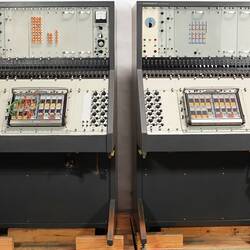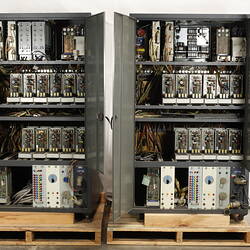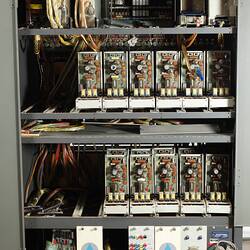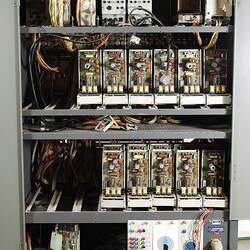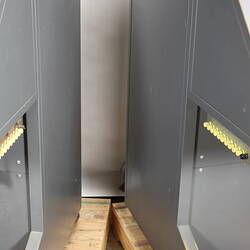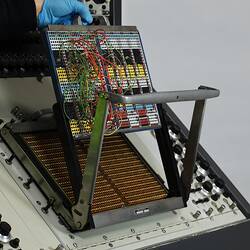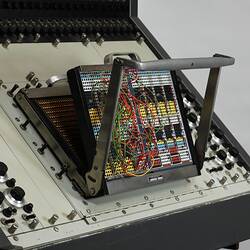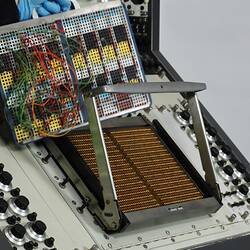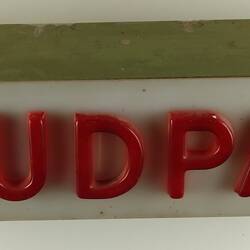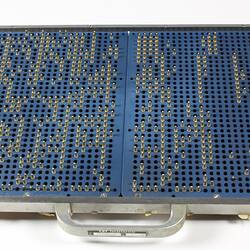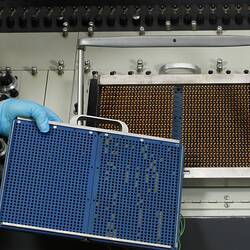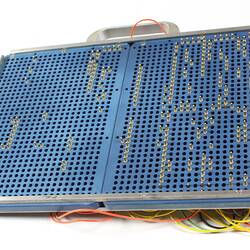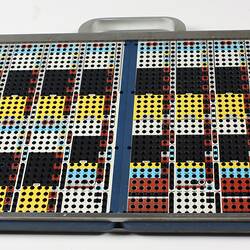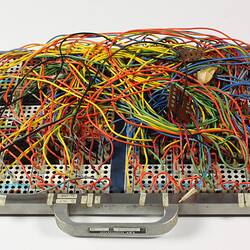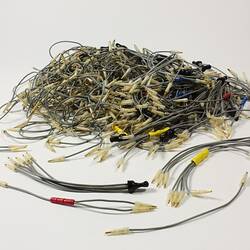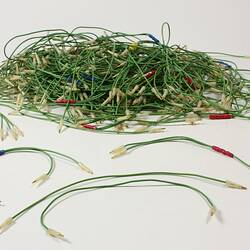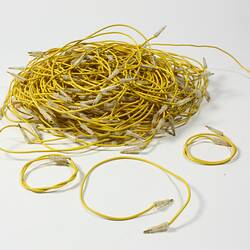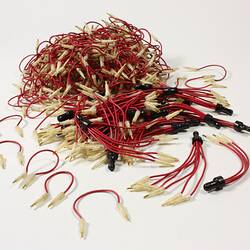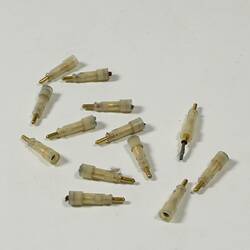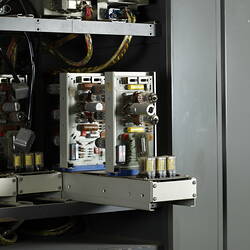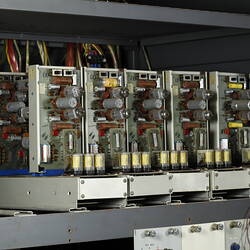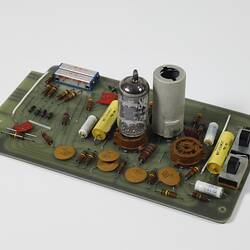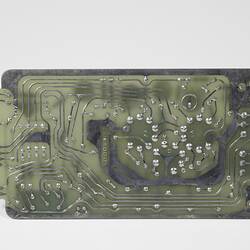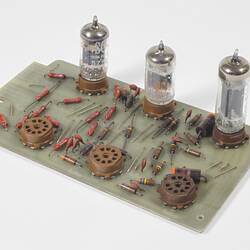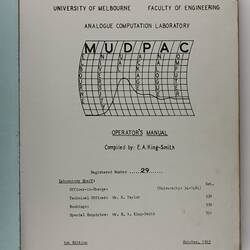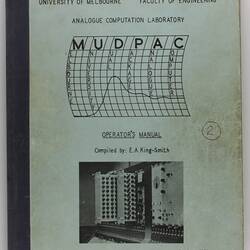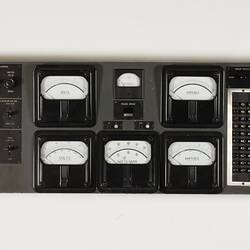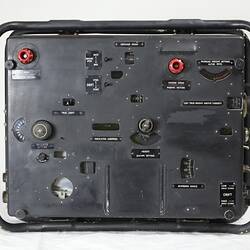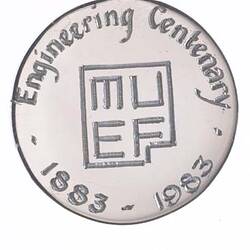Summary
Melbourne University Dual Package Analogue Computer (MUDPAC) consists of two consoles with patchboards. Made by Applied Dynamics, Ann Arbor, Michigan, U. S. A. And delivered to Melbourne University in 1961. The cost was $70,000. It was Applied Dynamics' first exported machine. The machine was used from 1961 to about 1986.
Uses of the machine included: electric power system analysis, circuit design, servo systems investigations, mechanical and aerodynamical vibration analysis, aircraft flight characteristics, chemical plant simulation, chemical reactions kinetics, nuclear reactor performance and control, structural analysis, hydraulic problems (surface and underground), biological system investigation and economic system behaviour.
The University hired one technician to service it. The two consoles were wired together, providing extra processing power. A non- linear plug panel was later added on the top half. Output was mainly on strip-charts, sometimes on oscilloscopes. Still in use by 1986, it was used at the University until the technician retired. MUDPAC was principally used for the solving of engineering problems. Similar computers were used for process control in oil refinery at Altona, by a car manufacturer and by a paper pulp mill.
Each console contains 64 operational amplifiers (op-amps), 80 coefficient potentiometers, 16 electronic multipliers, 8 diode function generators, and 20 diode networks. The problem to be solved was wired by means of patch cords on a 1632-hole removable patchboard.
The donation also included:
* Illuminated MUDPAC sign, which hung over the MUDPAC laboratory in the Engineering Building at Melbourne University; it is the counterpart of the CSIRAC sign which hung over the door of its digital rival in the Physics Building on the other side of the University campus.
Physical Description
Two separate consoles (with connection ports) accompanied by operator's manuals, patchboard and patchcords, plug connectors, spare electronic valves, operational amplifier modules, integrator modules and an illuminated sign. For a detailed list of descriptions of items in the MUDPAC Collection, please see the Narrative entitled: 'The Melbourne University Dual Package Analogue Computer:Collection - Inscriptions & Descriptions'.
Significance
In the early days of electronic computing (up to, say, the end of the 1960s), there was rivalry and debate between two camps of computing: digital computing on the one hand, analog (or analogue) computing on the other. There was no certainty as to which type of computer would be the dominant type or even that one type would dominate the other.
Analog computers were easier to program than digital computers and faster in solving certain classes of problems. However, with later advances in the ability to store and manipulate information in digital form, digital computers won the contest against analog computers.
More Information
-
Collection Names
Melbourne University Dual Package Analogue Computer (MUDPAC) Collection
-
Collecting Areas
-
Acquisition Information
Donation from Electrical & Electronic Engineering Department, University of Melbourne (The), 02 Dec 1987
-
Manufacturer
Applied Dynamics Inc, Ann Arbor, Michigan, United States of America, 1961
-
User
Engineering Faculty, University of Melbourne (The), Melbourne, Victoria, Australia, 1961-1969
-
Inscriptions
Rear bottom of Console # 1: Manufacturer's plate: Applied Dynamics, Inc./NAME Analog computer/PART NO. 146448/SER. NO -1/ANN ARBOR MICHIGAN White sticker: UNIVERSITY OF MELBOURNE/No 9842 Red sticker: F001 Rear bottom of Console # 2: Manufacturer's plate: Applied Dynamics, Inc./NAME Analog computer/PART NO. 146448/SER. NO -2/ANN ARBOR MICHIGAN White sticker: UNIVERSITY OF MELBOURNE/No 9843 Red sticker: F002 For a detailed list of inscriptions on items in the MUDPAC Collection, please see the Narrative entitled: 'The Melbourne University Dual Package Analogue Computer:Collection - Inscriptions & Descriptions'.
-
Classification
Computing & calculating, Analogue computing, Computer systems
-
Category
-
Discipline
-
Type of item
-
Overall Dimensions
2330 mm (Length), 660 mm (Width), 1300 mm (Height)
-
Part Dimensions
1150 mm (Length), 660 mm (Width), 1300 mm (Height)
Approximate dimensions of each console.
-
Part Dimensions
340 mm (Length), 262 mm (Width), 20 mm (Height)
Approximate dimensions of each patch board.
-
Keywords
Analogue Computers, Applied Dynamics, Computer Technology, Computing, Computers, Electronics, Electronic Engineering, Electronic Engineering, Thermionic Electron Valves, Computer Engineering, Computer Hardware, MUDPAC (Computer)


